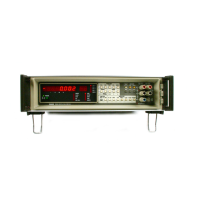8505A
2-46= Measurement Terminals
and Controls
2-47. GUARDING
2-48.
General
2-49. Guarding may be used
to reduce
noise and
improve accuracy.
Common mode voltages, resulting
from currents
and voltage drops between two points
otherwise
electrically
common,
may
cause significant
errors.
Proper use of a
floating, guarded multimeter
minimizes these errors.
2-50. Generally,
guarding should be employed where
long signal leads
are used, when signal
source impedance
is
high, when
making measurements near high-level
radiated
noise
(particularly at the power line frequency),
or when
making floating
measurements.
NOTE
Errors due
to thermal
emfs
should
be
considered
when
making low level, high
resolution
measurements. Thermal
emfs
(voltages
produced
by
temperature
differences
between contacts
of
two
dissimilar
metals
or
by
temperature gradients along
a
length
of
material) may cause
differences
of
several
microvolts. The use
of
low
emf,
shielded cables with copper spade lugs
is
recommended to
minimize
thermal
emf
errors.
2-51.
Guard Selector
2-52. Correct use of the
multimeter GUARD terminal
both
protects the
instrument and
provides
more accurate
readings. The
EXT GD IN
selector, when disengaged
(out),
enables the internal
guard connection. In many
cases
accurate measurements
may be made with the
selector
in this position
(shown as A in Figure 2-4). Here,
the
difference in
potential between multimeter ground
and
device ground is
very small, or the measurement is
not
critical. When pushed
in, the selector disables the
internal
guard connection and allows for
external guard
connections as
shown in B and C of Figure
2-4.
The
connection
shown in B is better than that
in A, since some
common
mode current (ICM) is
shunted away from the
source
resistance. The
connection shown in C is necessary
when
the source may
not be capable of
driving the guard.
The
buffer
amplifier shown in C prevents this source
loading.
Practical
considerations usually dictate which of
the three
connections is used.
2-53.
Guard
Terminal
2-54. Recommended
guard terminal
connections are
illustrated in
Figure
2-4.
The
potential between GUARD
and
chassis ground must
not exceed
500V.
The
potential
between
SENSE LOand GUARD
must not exceed 127V.
2-55. VOLTS INPUT/OHMS
SENSE (HI and LO)
TERMINALS
2-56.
The
VOLTS
INPUT/OHMS SENSE terminals
are used
when making voltage
(dc and/or ac) and
resistance
measurements.
Connections are
shown in
Figure
2-5.
The input
on the HI terminal with respect
to
the
LO
terminal must not exceed 1000V. The LO to
GUARD
potential must not exceed I27V. These
terminals
are
internally shorted
to the AMPS
INPUT/OHMS
SOURCE terminals (HI to HI, LO to
LO)
when the
Ohms
Selector
(4T
OHMS IN)
is in the
disengaged
(2-wire)
position.
NOTE
In
OHMS
measurements, the voltage at the
SENSE IN
PVT terminals is sampled
before
the
Ohms
Converter (Option
02)
is connected.
No
connection is made
if
excessive voltage
(±I0V
dc)
is present.
2-57.
AMPS
INPUT/OHMS SOURCE (HI and LO)
TERMINALS
2-58. The AMPS
INPUT/OHMS SOURCE
terminals
are used
when making current (A DC or A AC) or four-
wire resistance
(OHMS) measurements. The potential
between SOURCE HI and
SOURCE
LO
must not
2-19

